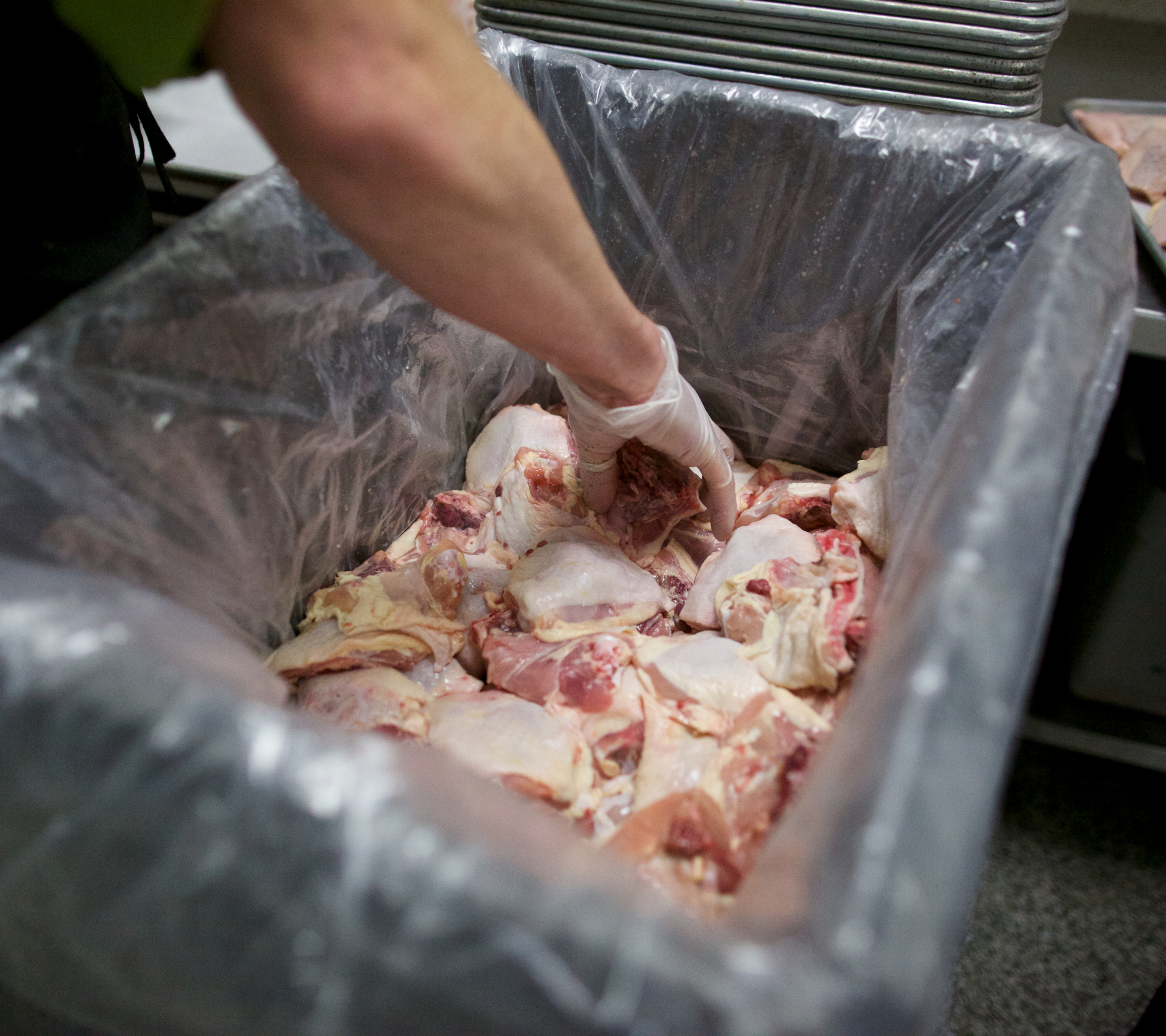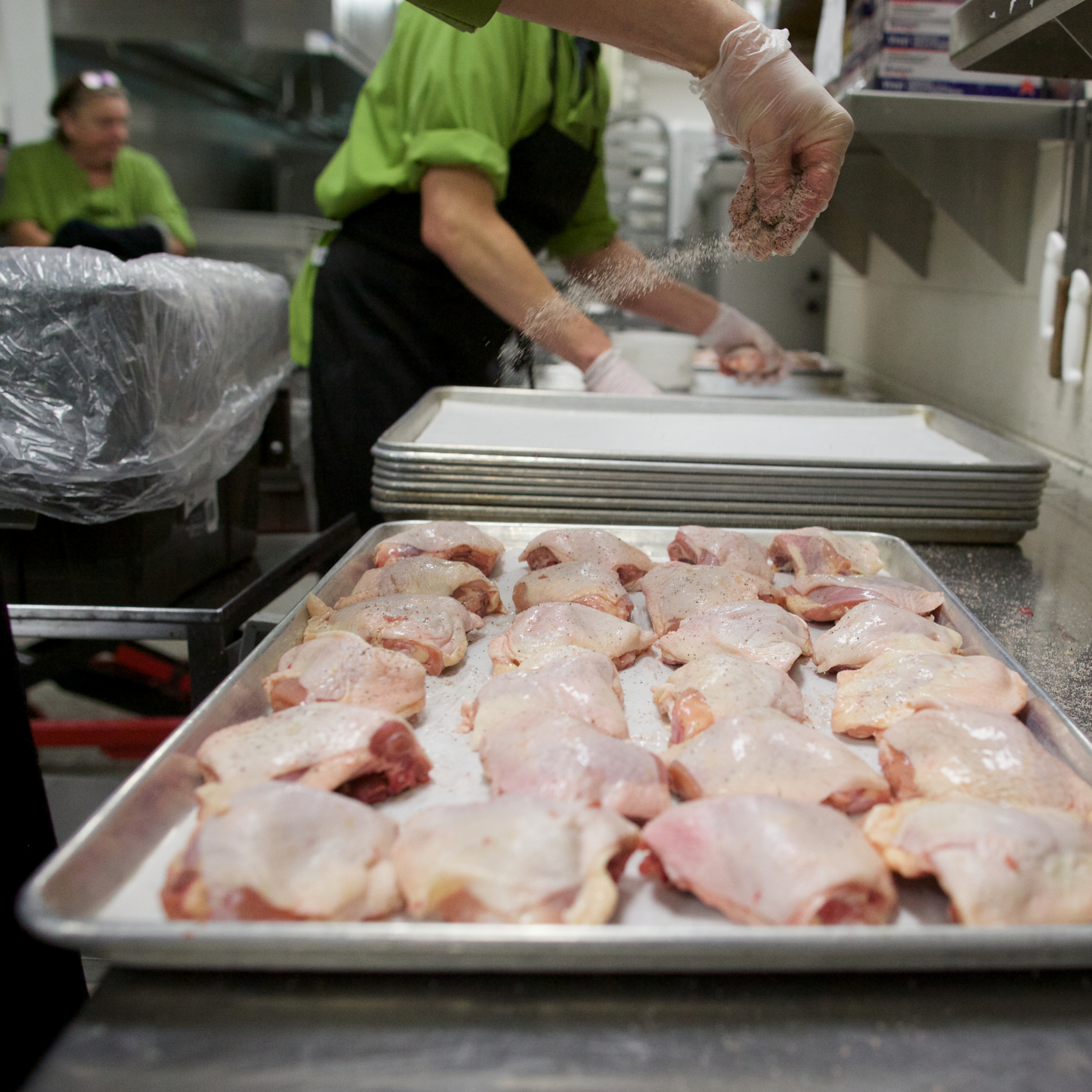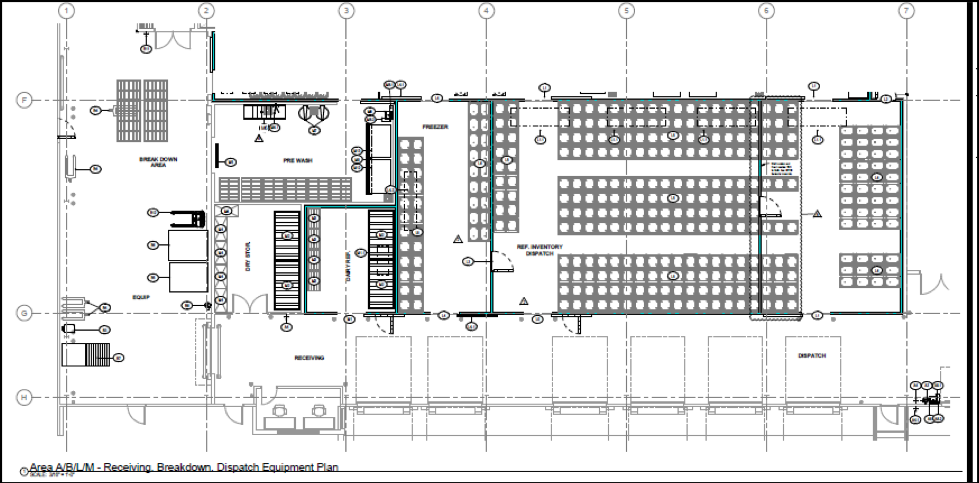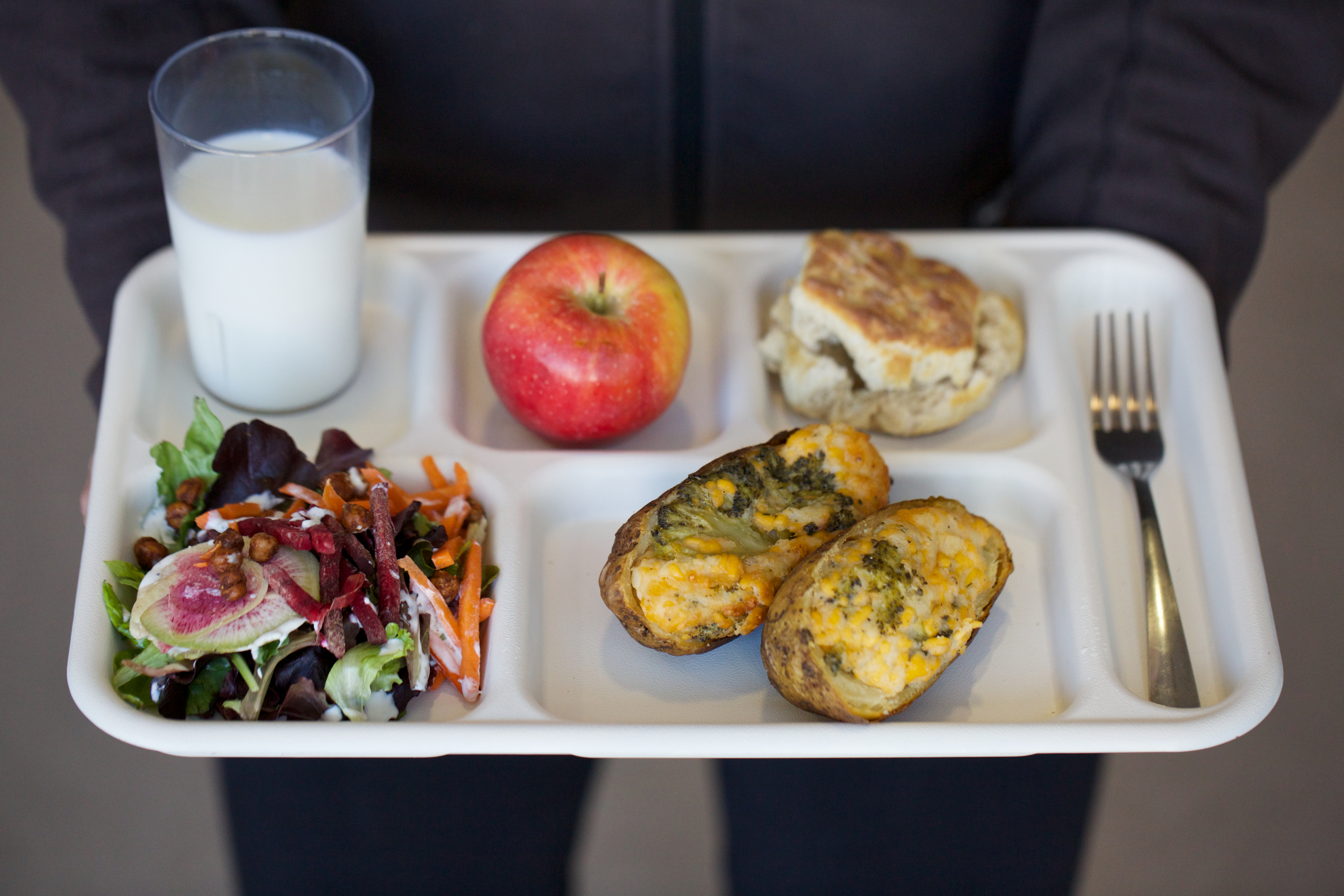
Central Kitchen Case Study: Menu & Procurement
Case study quick links: intro & planning, benefits, design & construction, menu & procurement (current page), staffing, and community engagement.
Inventory Transformation
With the Culinary Center’s 7,000 square feet of storage and the new sous vide system (as well as large volume kettles, pumping systems, and processing equipment), ingredient inventory management will experience a significant system transformation.

Central Kitchen Case Study: Menu & Procurement
Case study quick links: intro & planning, benefits, design & construction, menu & procurement (current page), staffing, and community engagement.
Inventory Transformation
With the Culinary Center’s 7,000 square feet of storage and the new sous vide system (as well as large volume kettles, pumping systems, and processing equipment), ingredient inventory management will experience a significant system transformation.
Calculating Facility Size
When estimating the size of the facility, the FSD team created a process document for each recipe used in the menu cycle.
To determine facility size, the FSD evaluated the following details for each recipe:
- volume and weight
- purchasing quantities
- amount of time in storage
- prep time
- equipment used
- time until delivery
- finishing process at the satellite sites and other details


To determine facility size, the FSD evaluated the following details for each recipe:
- volume and weight
- purchasing quantities
- amount of time in storage
- prep time
- equipment used
- time until delivery
- finishing process at the satellite sites and other details
This information, along with purchasing histories of the warehouse and the Regional PKs provided the data required to estimate the size of storage, cold and hot prep, cooking equipment size, and the packing and dispatch area specifications in the CC design. The more common method to determining facility size is to multiply a square foot per meal formula, like 1.5 or 1.8 times the meal count. Using a menu and production forward system provides a much more accurate determination of the facility needs to support the flow of food.
Deliveries
Consolidating production to a central facility saves funds through centralizing all vendor deliveries to one location. Single location delivery may also increase the number of responders to the RFPs (and thus competition), which for some vendors, like produce or milk, which required delivery to 51 sites with very tight time constraints, often did not have many responders. In BVSD, the current warehouse has been used as much as possible to centralize some deliveries, but there has remained direct delivery of produce and milk to all locations as well as direct prime vendor deliveries to the three Regional Production Kitchens (PKs) and the Catering Kitchen.

The three Regional PKs have minimal storage space and relied more on “just-in-time” deliveries to manage production, both from the prime vendor and the warehouse deliveries. USDA commodity foods (brown box and processed) have been delivered to the warehouse and DoD produce has been delivered direct to all sites. In some years, the FSD has had to rent freezer storage in Denver to accommodate bulk orders of commodity brown box. Diverting some commodity allocation to processed commodities was utilized to control the flow of inventory and eliminate the need for outside storage.
With a single location for storage and production, the possibilities of how food is procured and stored shifts dramatically. The potential for allocating more space for the most frequently used ingredients will allow for fewer, larger deliveries of an item and provides great cost savings potential.

The three Regional PKs have minimal storage space and relied more on “just-in-time” deliveries to manage production, both from the prime vendor and the warehouse deliveries. USDA commodity foods (brown box and processed) have been delivered to the warehouse and DoD produce has been delivered direct to all sites. In some years, the FSD has had to rent freezer storage in Denver to accommodate bulk orders of commodity brown box. Diverting some commodity allocation to processed commodities was utilized to control the flow of inventory and eliminate the need for outside storage.
With a single location for storage and production, the possibilities of how food is procured and stored shifts dramatically. The potential for allocating more space for the most frequently used ingredients will allow for fewer, larger deliveries of an item and provides great cost savings potential.
Above: Reusable plastic containers (RPCs) are used to deliver some products. This image shows raw, whole muscle meat in an RPC.
Milk will be delivered centrally and then picked up and delivered to the sites. Centralizing all produce procurement will be a dramatic shift for the FSD. Produce may arrive in gaylords of apples, melons, or citrus to the CC as opposed to cases, most of which were delivered directly to the sites.
In the former model, the produce companies delivered salad greens (mesclun and chopped romaine), tomatoes (in season), and fruits like apples, bananas, citrus fruits, etc. directly to all 51 school sites, while the rest of the salad bar vegetables and hot line vegetables were received and prepped at the Regional PKs.
In the new model, the CC will be the “vendor” for all produce. There will be a trade-off of labor – what was formerly performed three times in three different places will happen once at the CC. Washing of fruit will still take place at the site level.
Keywords
In the U.S. and Canada, the term gaylord is sometimes used for triplewall corrugated pallet boxes; this is due to the first bulk bins being manufactured by the original Gaylord Container Company of St. Louis, which was acquired by Crown Zellerbach of San Francisco in 1955. - Wikipedia
Never-ever signifies no growth implants, no antibiotics (including ionophores), and no animal by-products in the feed. - Beef Magazine
Procurement
Local Procurement Opportunities
The CC will also expand opportunities in procurement of locally and regionally produced ingredients. The relationships with local farmers for produce, which currently operates based on annual projections of products that are menued during the school year, operating with a weekly offering system, may expand to contracting specific crops like tomatoes, hard squash, and dried beans that can be purchased in volume and processed in the CC during the summer for use during the school year.
Commodities
The move to CC will also impact how the FSD allocates their USDA Commodity allocation. The FSD receives approximately $500,000 in USDA commodity allocation. The FSD expects to transfer more of their allocation to DoD, eliminating the reliance on pre-cooked meats like chicken and beef meatballs, which are procured through USDA processing. Pre-cooked diced chicken is featured in many recipes and shifting these types of key ingredients to commercial raw purchases to be cooked in-house will be the final step in what has been a steady shift to the use of raw proteins since the inception of the program.
Since 2009-10, eliminating processed meats has been a priority for the FSD:

First, pre-cooked beef patties with fillers were replaced with frozen, raw USDA commodity beef patties. Then beef patties shifted to regionally produced raw frozen, and finally to regionally produced “Never-ever” beef patties received fresh.
Pre-cooked turkey, turkey, ham, and deli meats shifted to roasting commercially-purchased frozen, raw turkey and slicing in-house.
Chicken on the bone was introduced in year one using pre-cooked, frozen chicken on the bone and then shifted to IQF (individually quick-frozen), raw, frozen chicken parts on the bone and eventually to CRAU certified or ABF (antibiotic-free) bone-in thighs, drumsticks, chicken tenders, chicken breast strips and boneless thighs delivered fresh. The volume of chicken is high, so the commodity pre-cooked chicken has been a staple throughout the first 11 years.

First, pre-cooked beef patties with fillers were replaced with frozen, raw USDA commodity beef patties. Then beef patties shifted to regionally produced raw frozen, and finally to regionally produced “Never-ever” beef patties received fresh.
Pre-cooked turkey, turkey, ham, and deli meats shifted to roasting commercially-purchased frozen, raw turkey and slicing in-house.
Chicken on the bone was introduced in year one using pre-cooked, frozen chicken on the bone and then shifted to IQF (individually quick-frozen), raw, frozen chicken parts on the bone and eventually to CRAU certified or ABF (antibiotic-free) bone-in thighs, drumsticks, chicken tenders, chicken breast strips and boneless thighs delivered fresh. The volume of chicken is high, so the commodity pre-cooked chicken has been a staple throughout the first 11 years.
The CC facility design was intentionally designed to use raw proteins and may be the first large school district in the United States to fully discontinue use of pre-cooked USDA commodity chicken.
Bulk Storage
In food service inventory management, the pallet count of each storage area is the bread and butter of determining PARs (periodic automatic replenishment) for ingredients and supplies. In the CC, the FSD will have a lot of space to work with and be able to implement the most efficient inventory management system. The BVSD warehouse was not built dedicated to food service and the space available had to be tightly managed for ingredient turnover.
The following table (Pallet Count Comparison) shows the difference between the current warehouse pallet count versus the CC storage for bulk dry, refrigerated and freezer. The CC bulk storage will be “four-high”, meaning four pallet stack shelving high. The current FSD freezer has no shelves and only some products can be double-stacked.
| Current Count | Culinary Center Count | Difference | % Increase | |
|---|---|---|---|---|
| Dry | 129 | 156 | 27 | 17% |
| Fridge & Milk | 15 | 120 | 105 | 88% |
| Frozen | 70 | 208 | 138 | 66% |
| Total | 214 | 484 | 270 | 56% |
Dock Area
The dock area of the CC will receive food and supplies into bulk storage as well as dispatch the FSD trucks to the sites from the large refrigerated dispatch space adjacent to the docks. Two docks are incoming, four docks are outgoing, and the three smaller roll-up doors are for trash, recycle and compost.

Above: Illustration of dock area
Below: Equipment plan for receiving, breakdown, and dispatch

Menu Planning Redesign
The FSD’s menu planning has always been innovative and challenging with new menu items each year, some coming to the program via the many annual Iron Chef competitions. The “Fireside Potato” from the inaugural Iron Chef competition is still popular and remains a standard.
The current challenge for the team is to translate the menu into its production model at the CC with equipment and processes that will be new to everyone on the team. All recipes and menu cycles are currently managed through Horizons Software. Reconfiguring existing recipes for the new system affects the CC version of the recipes as well as the Satellites’ version.


Menu Planning Redesign
The FSD’s menu planning has always been innovative and challenging with new menu items each year, some coming to the program via the many annual Iron Chef competitions. The “Fireside Potato” from the inaugural Iron Chef competition is still popular and remains a standard.
The current challenge for the team is to translate the menu into its production model at the CC with equipment and processes that will be new to everyone on the team. All recipes and menu cycles are currently managed through Horizons Software. Reconfiguring existing recipes for the new system affects the CC version of the recipes as well as the Satellites’ version.
For example, the current method of roasting chicken involves:
Roast raw chicken to 145 degrees in the Production Kitchens.
Chill, pan, and ship the roasted chicken to the Satellite Kitchens.
The Satellites re-roast to 165 degrees, which may have variable results.
The Culinary Center allows an alternative cooking system:
Raw chicken is brined and bagged, then cooked in the sous vide system.
The sous vide-cooked chicken is labeled and shipped in bags to the Satellites.
Lastly, the chicken is roasted for the first time at the Satellites.
This results in a greater product yield due to eliminating the initial dry heat cooking, and results in a moister perfectly cooked product. Additionally, the Satellite kitchens will have less cleaning and much more efficiency.
With the shift to sous vide, inventory management will include “finished-goods” inventory, which was never possible in the past. Because of the extended shelf life, ingredients that can be cooked sous vide in large batches can be stocked in inventory for 21-28 days, which will create great efficiency in the overall system and also creates more potential for production timelines, which in the past were limited to two-days with shipping the night before service.
Recommended Next Topic: Staffing
There are many design considerations to take into account when planning your central kitchen. For example, your menu and food safety practices should influence design decisions.
Recommended Next Topic: Staffing
There are many design considerations to take into account when planning your central kitchen. For example, your menu and food safety practices should influence design decisions.






